heater FIAT DOBLO COMBI 2012 Owner handbook (in English)
[x] Cancel search | Manufacturer: FIAT, Model Year: 2012, Model line: DOBLO COMBI, Model: FIAT DOBLO COMBI 2012Pages: 283, PDF Size: 6.31 MB
Page 54 of 283
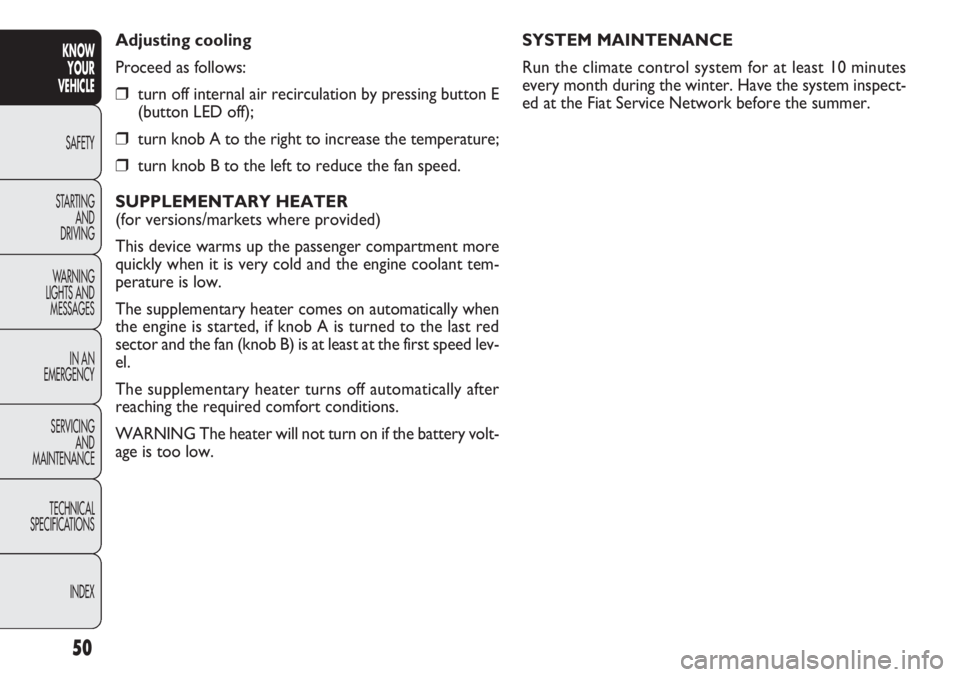
50
KNOWYOUR
VEHICLE
SAFETY
ST AR
TING AND
DRIVING
WARNING
LIGHTS AND MESSAGES
IN AN
EMERGENCY
SERVICING AND
MAINTENANCE
TECHNICAL
SPECIFICATIONS
INDEX
SYSTEM MAINTENANCE
Run the climate control system for at least 10 minutes
every month during the winter. Have the system inspect-
ed at the Fiat Service Network before the summer.
Adjusting cooling
Proceed as follows:
❒turn off internal air recirculation by pressing button E
(button LED off);
❒turn knob A to the right to increase the temperature;
❒turn knob B to the left to reduce the fan speed.
SUPPLEMENTARY HEATER
(for versions/markets where provided)
This device warms up the passenger compartment more
quickly when it is very cold and the engine coolant tem-
perature is low.
The supplementary heater comes on automatically when
the engine is started, if knob A is turned to the last red
sector and the fan (knob B) is at least at the first speed lev-
el.
The supplementary heater turns off automatically after
reaching the required comfort conditions.
WARNING The heater will not turn on if the battery volt-
age is too low.
Page 61 of 283
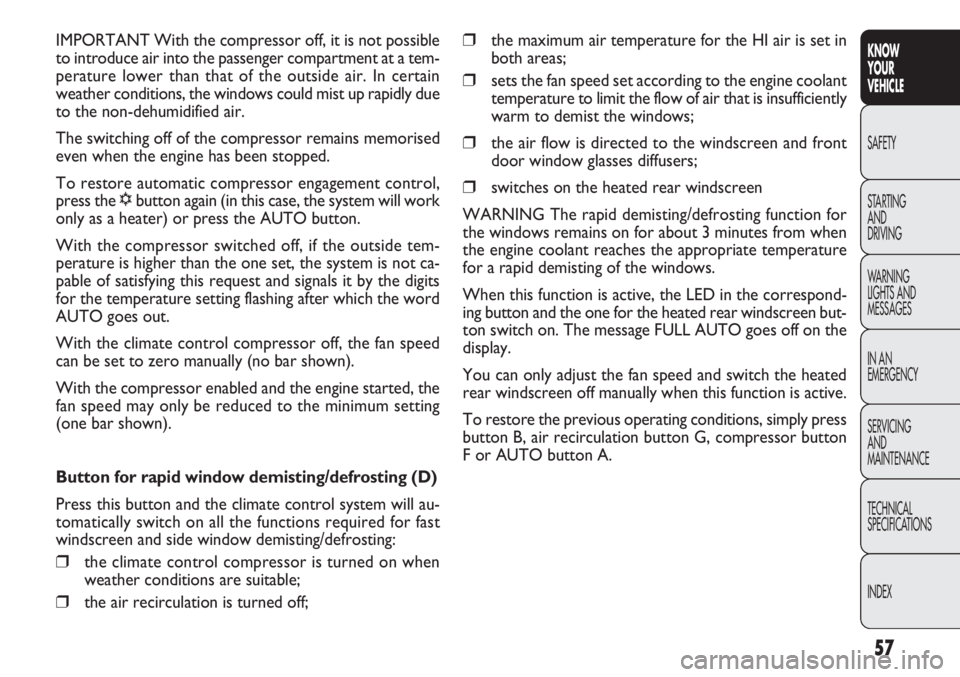
57
KNOW
YOUR
VEHICLE
SAFETY
STAR
TING
AND
DRIVING
WARNING
LIGHTS AND
MESSAGES
IN AN
EMERGENCY
SERVICING
AND
MAINTENANCE
TECHNICAL
SPECIFICATIONS
INDEX
❒the maximum air temperature for the HI air is set in
both areas;
❒sets the fan speed set according to the engine coolant
temperature to limit the flow of air that is insufficiently
warm to demist the windows;
❒the air flow is directed to the windscreen and front
door window glasses diffusers;
❒switches on the heated rear windscreen
WARNING The rapid demisting/defrosting function for
the windows remains on for about 3 minutes from when
the engine coolant reaches the appropriate temperature
for a rapid demisting of the windows.
When this function is active, the LED in the correspond-
ing button and the one for the heated rear windscreen but-
ton switch on. The message FULL AUTO goes off on the
display.
You can only adjust the fan speed and switch the heated
rear windscreen off manually when this function is active.
To restore the previous operating conditions, simply press
button B, air recirculation button G, compressor button
F or AUTO button A.
IMPORTANT With the compressor off, it is not possible
to introduce air into the passenger compartment at a tem-
perature lower than that of the outside air. In certain
weather conditions, the windows could mist up rapidly due
to the non-dehumidified air.
The switching off of the compressor remains memorised
even when the engine has been stopped.
To restore automatic compressor engagement control,
press the √
button again (in this case, the system will work
only as a heater) or press the AUTO button.
With the compressor switched off, if the outside tem-
perature is higher than the one set, the system is not ca-
pable of satisfying this request and signals it by the digits
for the temperature setting flashing after which the word
AUTO goes out.
With the climate control compressor off, the fan speed
can be set to zero manually (no bar shown).
With the compressor enabled and the engine started, the
fan speed may only be reduced to the minimum setting
(one bar shown).
Button for rapid window demisting/defrosting (D)
Press this button and the climate control system will au-
tomatically switch on all the functions required for fast
windscreen and side window demisting/defrosting:
❒the climate control compressor is turned on when
weather conditions are suitable;
❒the air recirculation is turned off;
Page 142 of 283
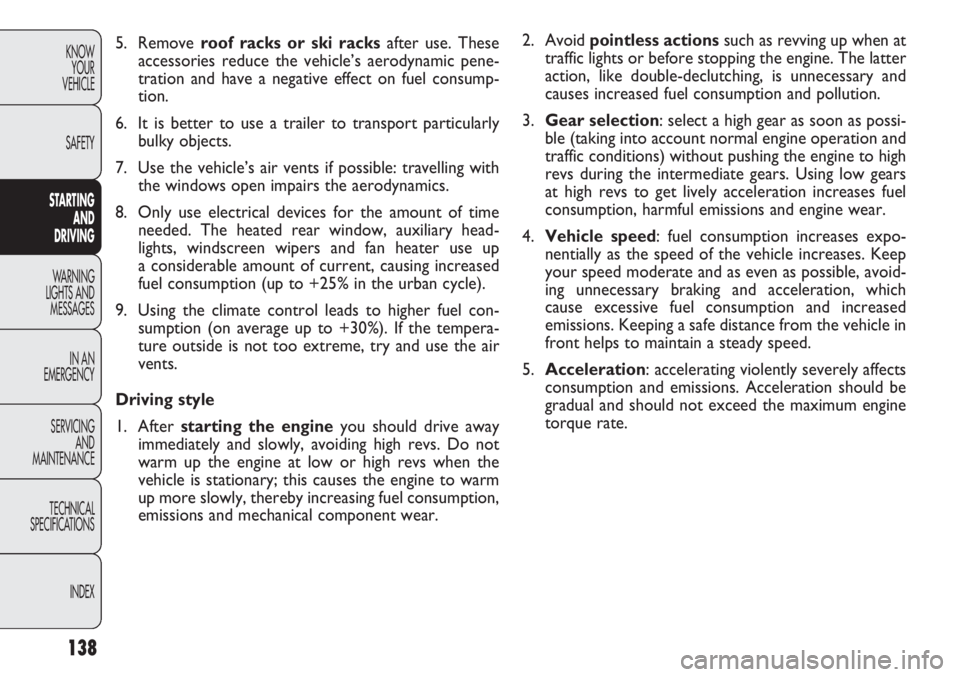
138
KNOWYOUR
VEHICLE
SAFETY
ST ARTING
AN
D
DRIVING
WARNING
LIGHTS AND MESSAGES
IN AN
EMERGENCY
SERVICING AND
MAINTENANCE
TECHNICAL
SPECIFICA TIONS
INDEX
2. Avoid pointless actions such as revving up when at
traffic lights or before stopping the engine. The latter
action, like double-declutching, is unnecessary and
causes increased fuel consumption and pollution.
3. Gear selection: select a high gear as soon as possi-
ble (taking into account normal engine operation and
traffic conditions) without pushing the engine to high
revs during the intermediate gears. Using low gears
at high revs to get lively acceleration increases fuel
consumption, harmful emissions and engine wear.
4. Vehicle speed: fuel consumption increases expo-
nentially as the speed of the vehicle increases. Keep
your speed moderate and as even as possible, avoid-
ing unnecessary braking and acceleration, which
cause excessive fuel consumption and increased
emissions. Keeping a safe distance from the vehicle in
front helps to maintain a steady speed.
5. Acceleration: accelerating violently severely affects
consumption and emissions. Acceleration should be
gradual and should not exceed the maximum engine
torque rate.
5. Remove
roof racks or ski racks after use. These
accessories reduce the vehicle’s aerodynamic pene-
tration and have a negative effect on fuel consump-
tion.
6. It is better to use a trailer to transport particularly bulky objects.
7. Use the vehicle’s air vents if possible: travelling with the windows open impairs the aerodynamics.
8. Only use electrical devices for the amount of time needed. The heated rear window, auxiliary head-
lights, windscreen wipers and fan heater use up
a considerable amount of current, causing increased
fuel consumption (up to +25% in the urban cycle).
9. Using the climate control leads to higher fuel con- sumption (on average up to +30%). If the tempera-
ture outside is not too extreme, try and use the air
vents.
Driving style
1. After starting the engine you should drive away
immediately and slowly, avoiding high revs. Do not
warm up the engine at low or high revs when the
vehicle is stationary; this causes the engine to warm
up more slowly, thereby increasing fuel consumption,
emissions and mechanical component wear.
Page 187 of 283
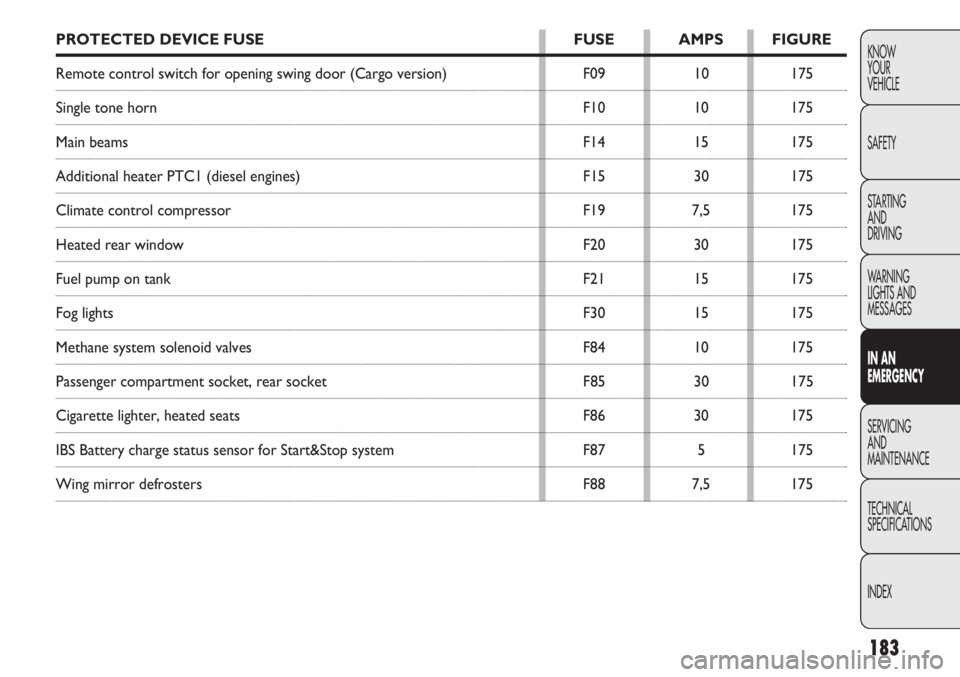
183
KNOW
YOUR
VEHICLE
SAFETY
STARTING
AND
DRIVING
WARNING
LIGHTS AND
MESSAGES
IN AN
EMERGENCY
SERVICING
AND
MAINTENANCE
TECHNICAL
SPECIFICATIONS
INDEXPROTECTED DEVICE FUSE FUSE AMPS FIGURE
Remote control switch for opening swing door (Cargo version) F0910175
Single tone horn F1010175
Main beams F1415175
Additional heater PTC1 (diesel engines) F1530175
Climate control compressor F197,5175
Heated rear window F2030175
Fuel pump on tank F2115175
Fog lights F3015175
Methane system solenoid valves F8410175
Passenger compartment socket, rear socket F8530175
Cigarette lighter, heated seats F8630175
IBS Battery charge status sensor for Start&Stop system F875175
Wing mirror defrosters F887,5175
Page 189 of 283
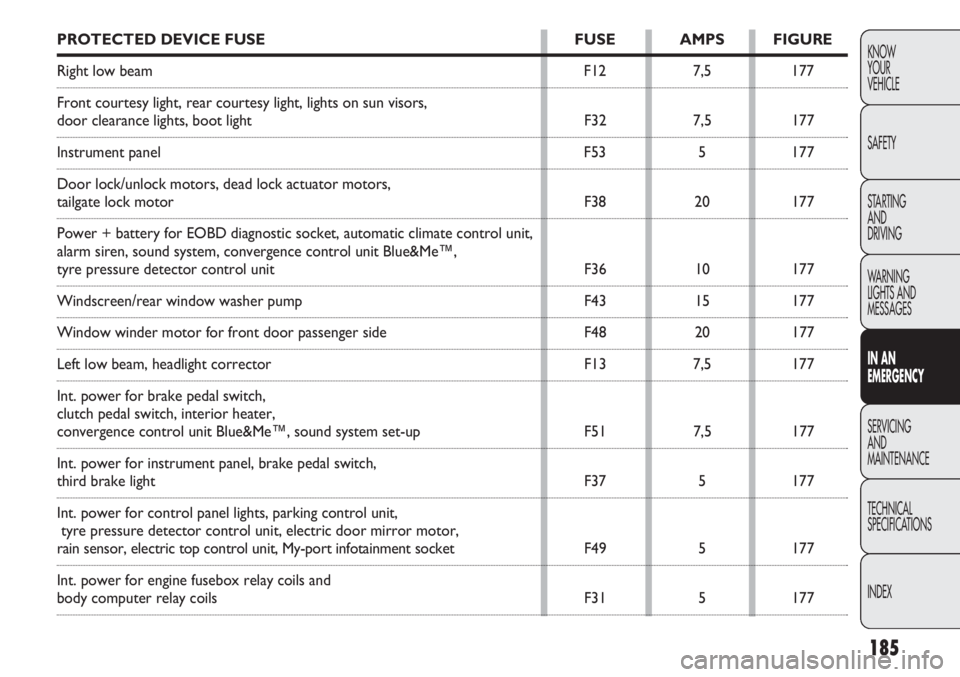
185
KNOW
YOUR
VEHICLE
SAFETY
STARTING
AND
DRIVING
WARNING
LIGHTS AND
MESSAGES
IN AN
EMERGENCY
SERVICING
AND
MAINTENANCE
TECHNICAL
SPECIFICATIONS
INDEXPROTECTED DEVICE FUSE FUSE AMPS FIGURE
Right low beam F127,5177
Front courtesy light, rear courtesy light, lights on sun visors,
door clearance lights, boot light F327,5177
Instrument panel F535177
Door lock/unlock motors, dead lock actuator motors,
tailgate lock motor F3820177
Power + battery for EOBD diagnostic socket, automatic climate control un\
it,
alarm siren, sound system, convergence control unit Blue&Me™,
tyre pressure detector control unit F3610177
Windscreen/rear window washer pump F4315177
Window winder motor for front door passenger side F4820177
Left low beam, headlight corrector F137,5177
Int. power for brake pedal switch,
clutch pedal switch, interior heater,
convergence control unit Blue&Me™, sound system set-up F517,5177
Int. power for instrument panel, brake pedal switch,
third brake light F375177
Int. power for control panel lights, parking control unit, tyre pressure detector control unit, electric door mirror motor,
rain sensor, electric top control unit, My-port infotainment socket F495177
Int. power for engine fusebox relay coils and
body computer relay coils F315177
Page 254 of 283
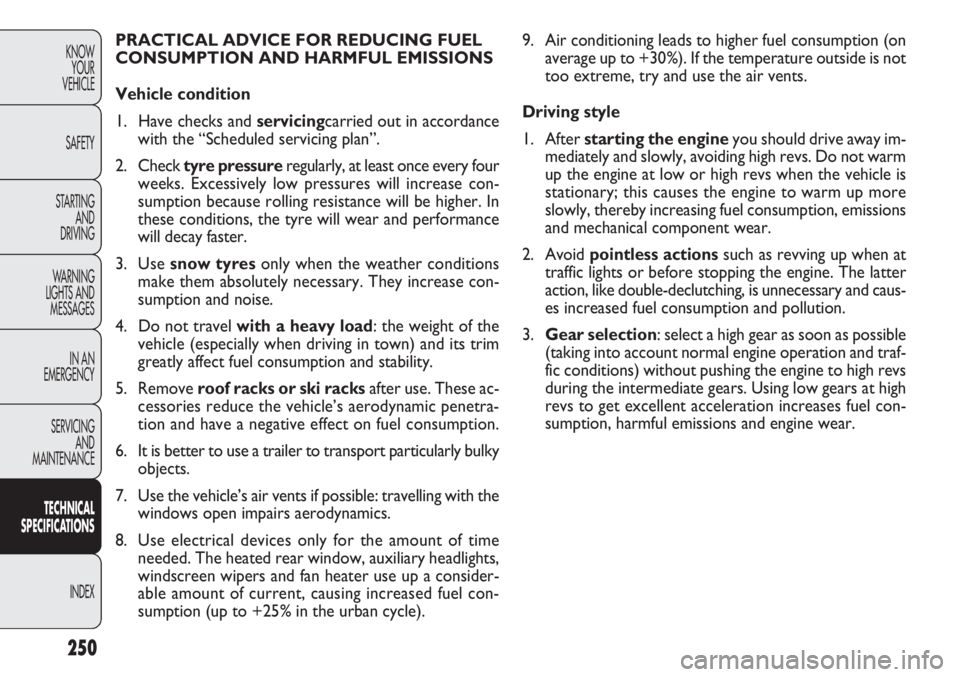
250
KNOWYOUR
VEHICLE
SAFETY
STARTING AND
DRIVING
WARNING
LIGHTS AND MESSAGES
IN AN
EMERGENCY
SERVICING AND
MAINTENANCE
TECHNICAL
SPECIFICAT IO
NS
INDEX
9. Air conditioning leads to higher fuel consumption (on average up to +30%). If the temperature outside is not
too extreme, try and use the air vents.
Driving style
1. After starting the engine you should drive away im-
mediately and slowly, avoiding high revs. Do not warm
up the engine at low or high revs when the vehicle is
stationary; this causes the engine to warm up more
slowly, thereby increasing fuel consumption, emissions
and mechanical component wear.
2. Avoid pointless actions such as revving up when at
traffic lights or before stopping the engine. The latter
action, like double-declutching, is unnecessary and caus-
es increased fuel consumption and pollution.
3. Gear selection: select a high gear as soon as possible
(taking into account normal engine operation and traf-
fic conditions) without pushing the engine to high revs
during the intermediate gears. Using low gears at high
revs to get excellent acceleration increases fuel con-
sumption, harmful emissions and engine wear.
PRACTICAL ADVICE FOR REDUCING FUEL
CONSUMPTION AND HARMFUL EMISSIONS
Vehicle condition
1. Have checks and
servicingcarried out in accordance
with the “Scheduled servicing plan”.
2. Check tyre pressure regularly, at least once every four
weeks. Excessively low pressures will increase con-
sumption because rolling resistance will be higher. In
these conditions, the tyre will wear and performance
will decay faster.
3. Use snow tyres only when the weather conditions
make them absolutely necessary. They increase con-
sumption and noise.
4. Do not travel with a heavy load: the weight of the
vehicle (especially when driving in town) and its trim
greatly affect fuel consumption and stability.
5. Remove roof racks or ski racks after use. These ac-
cessories reduce the vehicle’s aerodynamic penetra-
tion and have a negative effect on fuel consumption.
6. It is better to use a trailer to transport particularly bulky objects.
7. Use the vehicle’s air vents if possible: travelling with the windows open impairs aerodynamics.
8. Use electrical devices only for the amount of time needed. The heated rear window, auxiliary headlights,
windscreen wipers and fan heater use up a consider-
able amount of current, causing increased fuel con-
sumption (up to +25% in the urban cycle).